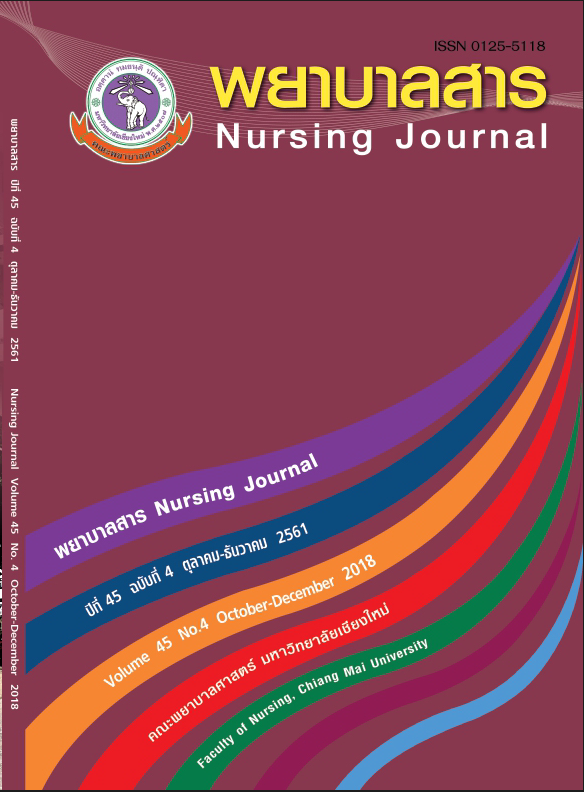บทบาทของพยาบาลในการดำเนินงานอาชีวอนามัยและสิ่งแวดล้อมในสถานประกอบการ
คำสำคัญ:
บทบาทของพยาบาล, การดำเนินงานอาชีวอนามัยและสิ่งแวดล้อม, สถานประกอบการบทคัดย่อ
ผลการวิจัยพบว่า กลุ่มตัวอย่างมีการปฏิบัติบทบาทผู้ให้ความรู้ ผู้วิจัย ผู้จัดการรายกรณี ผู้ให้การปรึกษา ผู้เชี่ยวชาญการสร้างเสริมสุขภาพ ผู้จัดการ และผู้ให้บริการทางคลินิก อยู่ในระดับมากเพียง ร้อยละ 9.56 – 18.26 ขณะที่บทบาทผู้วิจัยมีการปฏิบัติอยู่ในระดับน้อยถึงร้อยละ 35.65 โดยบทบาทผู้ให้บริการทางคลินิก ที่ส่วนใหญ่ (ร้อยละ 86.05) ปฏิบัติเป็นประจำ คือ การรักษาข้อมูลสุขภาพคนทำงานเป็นความลับ ขณะที่บทบาทผู้จัดการรายกรณีมีเพียง ร้อยละ 39.13 ที่มีการประสานส่งต่อหน่วยงานที่เกี่ยวข้องในการดูแลคนทำงานที่เจ็บป่วยและบาดเจ็บ มีเพียงหนึ่งในห้าของกลุ่มตัวอย่างที่ดำเนินกิจกรรมสร้างเสริมสุขภาพและป้องกันโรคที่ไม่เกี่ยวข้องกับการทำงานเป็นประจำ ขณะที่บทบาทผู้ให้ความรู้ ร้อยละ 37.39 มีการเผยแพร่ความรู้ให้คนทำงานในรูปแบบต่างๆ เป็นประจำ ที่น่าสังเกตคือ บทบาทผู้วิจัย กลุ่มตัวอย่างทุกคนไม่เคยทำการวิจัยและเผยแพร่ผลงานวิจัยด้านการพยาบาลอาชีวอนามัยและสิ่งแวดล้อม
ผลการวิจัยชี้ให้เห็นถึงความสำคัญของการเสริมสร้างการปฏิบัติตามบทบาทที่พึงประสงค์ในพยาบาลสำหรับการดำเนินงานอาชีวอนามัยและสิ่งแวดล้อมในสถานประกอบการ ผู้บริหารสถานประกอบการควรสนับสนุนให้พยาบาลได้รับการศึกษา อบรมเพิ่มเติมด้านการพยาบาลอาชีวอนามัยและสิ่งแวดล้อม เพื่อเสริมสร้างการปฏิบัติตามบทบาทที่จำเป็นของพยาบาลได้อย่างมีประสิทธิภาพ ส่งผลต่อการพัฒนาคุณภาพการบริการพยาบาลอาชีวอนามัยและสิ่งแวดล้อมในสถานประกอบการอย่างเป็นรูปธรรม
เอกสารอ้างอิง
Bureau of Occupational and Environmental Diseases, Department of Disease Control, Ministry of Public Health. (2006). Occupational health nursing manual. Nonthaburi: Ministry of Public Health.
Dirksen, M. E. (2006). Occupational and environmental health nursing: An overview. In M. K. Salazar (Ed.), Core curriculum for occupational and environmental health nursing (3rd ed., pp. 3-34). Saunders.
Hart, P. A., Lachat, A. M., & Fabrey, L. J. (2012). Occupational health nursing 2011 practice analysis. Retrieved from http://www.abohn.org/documents/ABOHN2011PracticeAnalysis Report.pdf
Hong, O., Chin, D. L., & Thomas, E. A. (2013). Global occupational health and safety responsibilities of occupational health nurses based in the United States. Workplace health & safety, 61(7), 287-295.
Ishihara, I., Yoshimine, T., Horikawa, J., Majima, Y., Kawamoto, R., & Salazar, M. K. (2004).
Defining the role and functions of occupational health nurses in Japan: Result of job analysis. American Association of Occupational Health Nurses Journal, 52(6), 230-241.
Krejcie, R., & Morgan, D. W. (1970). Determining sample size for research activities. Educational and Psychological Measurement, 30, 607-610.
Marziale, M. H. P., Hong, O. S., Morris, J. A., & Fernanda Ludmilla Rossi Rocha, F. L. R. (2010). The roles and functions of occupational health nurses in Brazil and in the United States. Rev. Latino-Am. Enfermagem, 18(2), 182-188.
Ministry of Labor. (2005). Ministerial regulation on welfare in workplaces, 2005. Retrieved from http://www.labour.go.th/th%20/webimage/images/law/doc/welfare_2548.pdf
Nursing Division, Office of Permanent Secretary, Ministry of Public Health. (2014). Occupational health nursing standards. Nonthaburi: Nursing Division, Office of Permanent Secretary, Ministry of Public Health.
O’Donnell, M.P. (2002). Health promotion in the workplace (3rd ed). USA: Delmar.
Preechakoon, B., Tuvayanon, W., Netmuy, P., & Damrongrak, P. (2015). Professional Nurses’ Perceptions towards Images Influencing Value and Trust in Nursing Profession. Nursing Journal, 42(1), 122-131.
Rantanen, J. (2005). Basic occupational health services- their structure, content and objectives. SJWEH Suppl, 1, 5-15.
Rogers, B. (2003). Occupational and environmental health nursing: Concepts and practice (2nd ed.). Philadelphia: W.B. Saunders.
Rogers, B., Kono, K., Marziale, M. H. P., Peurala, M., Radford, J., & Staun, J. (2014). International survey of occupational health nurses' roles in multidisciplinary teamwork in occupational health services. Workplace health & safety, 62(7), 274-281.
Silapasuwan, P., Kaewboonchoo, O., Kalampakorn, S., Kaewpan, W., & Khan, P. (2007). Roles and Functions of Occupational Health Nurses according to the Standard of Professional Practices in Thailand. Journal of Public Health Nursing, 21(1), 60-79.
Sintuya, A. (2011). Roles of Professional Nurses for Occupational Health and Environmental Practices in Public Hospitals. (Master’s thesis of Nursing Science, Occupational Health Nursing). Graduate School, Chiang Mai University.
Sitalapreuk, V., Kulpwaropas, P., Pacharatrakul, W., Siriratana, J., Chanjarearn, S., & Untimano, O. (2002). Research report: Practice guidelines for occupational health nursing standard in the workplace (2nd ed.). Bangkok: The Thailand Research Fund.
Social Security Office, Ministry of Labor. (2014). Annual Report 2014: Workmen’s compensation fund. Retrieved from http://www.sso.go.th/wpr/uploads/uploadImages/file/AnnualReport Book2557.pdf
Sukbua, T., Kalampakorn, S., Kaewpan, W., & Powwattana, A. (2009). Factors Affecting the Role Performance of Occupational Health Nurses in Health Promotion. Journal of Public Health Nursing, 23(2), 28-44.
Salazar, M. K., Kemerer, S., Amann, M. C., & Fabrey, L. J. (2002). Defining the roles and functions of occupational and environmental health nurses: Results of a national job analysis. AAOHN journal: official journal of the American Association of Occupational Health Nurses, 50(1), 16-25.
Takala, J., Hämäläinen, P., Saarela, K. L., Yun, L. Y., Manickam, K., Jin, T. W., . . . & Lin, G. S. (2014). Global estimates of the burden of injury and illness at work in 2012. Journal of occupational and environmental hygiene, 11(5), 326-337.
Thailand Nursing and Midwifery Council. (2005). Announcement of Thailand Nursing and Midwifery Council: Standards for nursing and midwifery services in a secondary level and a tertiary level. Nonthaburi: Thailand Nursing and Midwifery Council.
Udomvong, N., Chanprasit, C., & Junyasiri, T. (2001). Research report: The need and the practice of occupational health nursing according to professional structural standard. Chiang Mai: Faculty of Nursing, Chiang Mai University.
U.S. Bureau of Labor Statistics. (2015). Employer–reported workplace injury and illness 2014. Retrieved from http://www.bls.gov/news.release/pdf/osh.pdf
Workplace Safety and Health Institute. (2014). Workplace safety and health report 2014. Retrieved from https://www.wshinstitute.sg/files/wshi/upload/cms/file/WSHI%20National%20Statistics% 20Report%202014.pdf
ดาวน์โหลด
เผยแพร่แล้ว
รูปแบบการอ้างอิง
ฉบับ
ประเภทบทความ
สัญญาอนุญาต
บทความที่ได้รับการตีพิมพ์เป็นลิขสิทธิ์ของวารสารพยาบาลสาร
ข้อความที่ปรากฏในบทความแต่ละเรื่องในวารสารวิชาการเล่มนี้เป็นความคิดเห็นส่วนตัวของผู้เขียนแต่ละท่านไม่เกี่ยวข้องกับมหาวิทยาลัยเชียงใหม่ และคณาจารย์ท่านอื่นๆในมหาวิทยาลัยฯ แต่อย่างใด ความรับผิดชอบองค์ประกอบทั้งหมดของบทความแต่ละเรื่องเป็นของผู้เขียนแต่ละท่าน หากมีความผิดพลาดใด ๆ ผู้เขียนแต่ละท่านจะรับผิดชอบบทความของตนเองแต่ผู้เดียว






